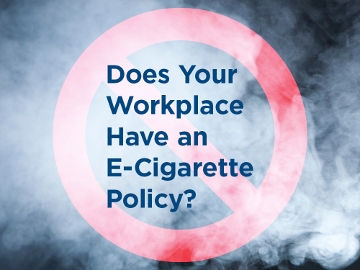- Home
- Loss Control
- Loss Control Insights
- 7 Steps for Developing an E-Cigarette Policy
You probably have a workplace policy on cigarette smoking. If your state or city regulates where smoking is allowed, you most likely have adjusted your policies on workplace smoking to match those laws.
But now, there’s a new dilemma: What do you do about the increase in e-cigarette use? Do you need a policy similar to your smoking policy, a policy with different parameters or no policy at all?
The Pros and Cons of E-Cigarette Use
As e-cigarettes become more popular, there is controversy over whether there are health risks and if this method of nicotine ingestion should be permitted in the workplace. Many experts admit that we don’t yet have all the answers, in part because e-cigarettes were just introduced into the United States in 2007 and there hasn’t been time to explore their long-term effects.Those in favor of e-cigarettes cite evidence that e-cigs are less harmful than traditional cigarettes and might help those who want to stop smoking. Those against quote studies that indicate the chemicals in the vapor, including some known carcinogens, are potentially harmful. These critics also issue reminders that even with a different form of inhalation and added flavors, e-cigarettes still contain nicotine, which is known to be both addictive and harmful.
Even with the uncertainty, your employees need to know what to expect in your workplace regarding this practice. This means you need to address e-cigarette use on the job in a written policy and ensure employees understand the policy.
Steps to Developing Your Policy
- Review your state and local e-cigarette laws. Check this state list of vaping laws. Some cities have also regulated where e-cigarettes may be used or where employers cannot restrict their use (especially outside the workplace). Be aware that the federal government requires all e-cigarette purchasers to be at least 18 years old.
- Determine the objectives for your workplace policy. Are you concerned about nicotine, harmful chemicals, secondhand vapors or time wasted in “vaping breaks”? Your objectives will help you determine what details your policy will include.
- Decide whether your e-cigarette policy will be the same as your smoking policy. Smoking and vaping risks are not exactly the same, so should your policies be the same? If the policies will be separate, what will the differences be? For example, if you allow a separate, enclosed area for smoking, your e-smoking area will also need adequate ventilation and should include heat detection. You may need to update your electrical safety policy to cover safe use of e-cigarette chargers and consider safe battery disposal.
- Review sample policies from other companies. This example amends a tobacco-free policy to include e-cigarettes in the workplace.
- Have your legal counsel review current smoking policies, as well as your proposed e-cigarette policies, to be sure any restrictions are legal and nondiscriminatory. For example, if you allow smoking cessation aids such as patches and gum, you may need to allow e-cigarettes for that purpose as well. If you ban e-cigarettes, have legal counsel be sure your written policy doesn’t accidentally ban the use of nicotine patches or gum (if you allow those items in your workplace now).
- Give employees a reasonable notice before your policy becomes effective.
- Keep up with changes in the law and updates on the safety of e-cigarette use, and review your policy periodically. As the popularity of e-cigarettes rises and more is known about the potential dangers of e-cigarette use, it’s likely that policies and best practices will continue to evolve.
Get in touch
Need help? We’re here for you! Whether you have questions or need personalized assistance, your local office is ready to support you.
Loss Control Insights
Stay informed with the latest news and receive actionable safety tips, all carefully curated by our team of experts.
